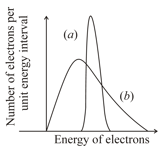Do alpha particles have discrete energies?
Important Questions on Nuclear Physics
Carbon decays to boron according to the following formula: .
Assume that positrons produced in the decay combines with free electrons in the atmosphere and annihilate each other almost immediately. Also, assume that the neutrinos are massless and do not interact with the environment. At , we have of . If the half-life of the decay process is , the net energy produced between time, and will be nearly,
[Given: atomic mass of atomic mass of atomic mass of particle is speed of the light]
Assertion (A) : Neutrino is chargeless and possesses spin.
Reason Neutrino exists inside the nucleus.
Originally the radioactive beta decay was thought as a decay of a nucleus with the emission of electrons only (Case I) . However, in addition to the electron, another (nearly) massless and electrically neutral particle is also emitted (Case II). Based on the figure below, which of the following is correct?

In which sequence the radioactive radiations are emitted in the following nuclear reaction?

